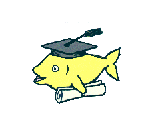
BOOKS EXCERPTS
To see the Table of Contents and the first few pages of the books click on the titles below:
Information Request Form
Return to Tackle Shop Helper Home Page
CATCHING MORE FRESH WATER FISH
Table of Contents
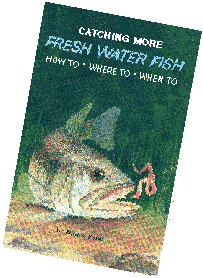
- Tips
- Equipment
- Bass
- Trout
- Walleye
- Muskie
- Striped Bass
- Catfish
- Pike
- Pond Fishing - Bream/Crappie
- Bait Rigging
- Trolling Rigs
- Bank Fishing
- Boat Fishing
- Trolling
- Knots (Improved Clinch, Palomar, Snelling/Uniknot, Surgeon's End Loop, Dropper Loop)
- Hooks
- Sinkers
- Recipes (Baked Catfish/Bass Filllets, Baked Rockfish, Lake Trout/Herb Catfish, Trout with Applesauce)
Book Excerpt
Tips For Catching More Fish
- Use fresh line - it's the most important part of your gear (and the cheapest). Replace it at least once
a year!
- Use only sharp hooks, check even the new ones!
- Use fresh bait and change it often to keep the level of the smellas high as possible.
- The best source of local information is your tackle shop. He knows the latest hot spots,
lures, colors, baits, etc.
- Observe the other anglers and learn.
- Know your quarry. Where does he live? What does he eat? Does he like slow bait, fast bait or a
still bait?
- Usually quiet is best. Remember that sound travels better in water; a dropped anchor in a boat
will chase the fish away in a hurry. Even keep your shadow off the water or light at night. Keep away
from the bank if your fish is a scary one (most are)!
- If you have a choice, look for the clearer water if you are hunting a fish that hunts by sight.
- If you're doing poorly, change something; lures, colors, places, baits, etc.
- Most successful fishermen keep the bait moving to attract fish (except the ones noted here).
- Keep all your gear in good shape, otherwise when you get that once in a lifetime fish on is when
it fails: keep reels oiled, guides in good shape, hooks sharp, etc.
- Go often - practice makes perfect!
Trout
- Where: Fast moving, clean water in continental USA
- Size: 1/2 - 1 pound
- Habits: Very cautious; they look for live bait
- How: Casting or natural bait
- What: Small spoons, surface flies, worms, salmon eggs, corn, cheese
- When: dull cloudy days best to keep from spooking the fish
- Season: Year-round: best in spring and fall
- Very cautious fish, don't splash or make noise, fish so shadow doesn't fall near fish
- Ask your local tackle shop for the current hot lure
- When water's cold, bait must be dropped right in front of them; they won't chase a lure as far as in
warmer water
- When fishing a stream, cast upstream and allow the bait to drift naturally with the current while
retrieving without allowing too much slack
Return to Tackle Shop Helper Home Page
SURF FISHING - CATCHING FISH FROM THE BEACH
Table of Contents
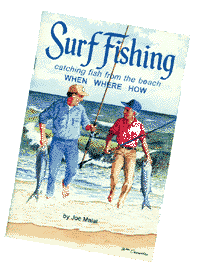
- Fish Caught in the Surf
- Rigs for Catching Fish in the Surf
- Hooks
- Terminal Tackle
- Sinkers
- Catching Fish with Bait
- Lure For Catching Fish in the Surf
- Knots
- Rods, Reels, Accessories
- How to Land a Fish in the Surf
- Tides, Currents and Winds
- Releasing for Better Future Fishing
Book Excerpt
Catching Striped Bass
Striped bass are among the most exciting fish to catch from the beach. While some stripers are caught
in the surf of the Atlantic coast as far south as North Carolina, most are found north of Delaware. Few
fish have the mystique, allure and dedicated following among surf-casters as the striper. They may
be unpredictable in their feeing habits. From Delaware south they are called rockfish.
- Where:
- Stripers tend to congregate around structure, such as points, jetties and bridges. They
are not frequently found along the open beach unless there is something about the bottom
profile to hold them in one place. Most surf fishing for stripers occurs along the northeast
coast, from Delaware to New England.
- When:
- Spring, summer and fall. They may be caught throughout the day if the fish show a
preference for feeding on a certain tide, bu most serious striper anglers fish the surf after
dark, when larger fish feel more comfortable in shallow water.
- How:
- Catch stripers of all sizes on swimming plugs such as Danny Plugs, Gibbs Swimmers or
Bottle Plugs and Atom Striper Swipers. The biggest stripers are consistently caught on live baits
such as live eels, hooked through the lips or eyes. Live menhaden can be fished from jetties,
but do not cast well from the beach.
- Tips:
- Fishing hard and often is the best way to catch a striped bass. After dark a slow retrieve
is mandatory for live eels and swimming plugs. Stripers can be leader shy. Avoid wire leaders.
- Size:
- Stripers are caught in all sizes. The world recor on rod and reel is 78 1/2 pounds, and
was caught from the surf near Atlantic City, New Jersey. The largest ever recorded weighed
128 pounds, and came from Edenton, North Carolina. Similar sized fish tend to school together.
Return to Tackle Shop Helper Home Page
CATCHING MORE PACIFIC SALT WATER FISH
Table of Contents
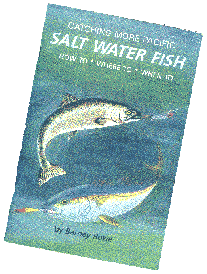
- Tips
- Equipment
- Calico Bass
- Yellowtail
- Bluefin Tuna
- Barracuda
- Bonito
- Lingcod
- Halibut
- Salmon
- Steelhead
- Sturgeon
- Striped Bass
- Rigging Baits
- Trolling
- Knots (Improved clinch, Palomar, Snelling, Blood knot, Spider hitch, Dropper loop)
- Hooks
- Sinkers
Book Excerpt
Yellowtail
- Where: Migrating up and down the Southern California coast
- Size: 6-30 pounds
- Habits: School fish in open water, usually around kelp beds
- How: Trolling fast (7-8 knots) near kelp beds
- Season: Year-round, but best in the summer
- What: Anchovy, squid, sardines, iron jigs
- During warm months they will be found near surface
- When water gets colder, they go deeper
- When feeding, they will attack anything that moves
- Birds working on the surface may indicate a school feeding
Barracuda
- Where: California coast
- Size: 3-10 pounds
- Habits: Open water
- How: Trolling or anchored and chummed to boat
- Season: April-October (a little longer in the south)
- What: Anchovies, squid, sardines, spoons, iron jigs
- Troll just outside kelp beds
- Excellent fighter and table fare
- Look for birds working; barracuda are probably feeding
- Often found near rocks and reefs feeding on little fish
Return to Tackle Shop Helper Home Page
CATCHING MORE FLOUNDER / FLUKE
AND OTHER BOTTOM FISH
Table of Contents
- Special Characteristics
- Where to Catch Flounder (Ocean, Bay, Surf)
- When to Catch Flounder
- How to Catch Flounder (Tips, Drifting, Trolling)
- What to Use to Catch Flounder (Equipment, Rigs, Lures, Rigging Bait)
- Knots (Improved Clinch, Palomar, Snelling/Uni-Knot, Dropper Loop)
- How to Handle a Flounder
- How to Fillet a Flounder
- Other Bottom Fish (Trout, Sea Bass, Tautog, Cobia, Grouper)
- Recipes (Fried, Baked, Au Gratin)
Book Excerpt
Introduction
Flounder (fluke) is the fishermen's most popular inshore fish, in bays and sounds, along the entire Atlantic
and Gulf Coasts. And it's a favorite of ocean fishers too.
Catching flounder requires more knowledge, skill and preparation than is needed to catch many other
kinds of saltwater fish.
The information in this book has been created by and gathered from the many experts listed on page 1.
It's knowledge that you would get from your local tackle shop (the best of all sources for fishing
information).
Keep this guide with your fishing gear; it's like having your local tackle shop expert right on the boat
with you! It will help you catch more flounder or fluke.
Flounder Characteristics
- Both eyes and coloration on same side
- So can lie concealed on bottom or hidden in sand
- Hunts from ambush
- Ability to match bottom where it hides
- Feeds on live baits - fish, shrimp, crabs
- Small needle-like teeth to hold food
- Swallows meal whole
- Migrates to deeper water in winter
When To Catch Flounder
- Look for tidal moving water - not too fast (1-2 knots ideal)
- Incoming best due to clearer water
- Outgoing has silt, pesticides, etc.
- Moves around during slack tides; hard to get enough oxygen while still or dug into sand
- Flounder always face into the current; this makes it easier to breathe and this is where its potential
meal comes from
- Height of tides move away from inlets and can be several hours later than posted time for inlet
Return to Tackle Shop Helper Home Page
CATCH MORE SALT WATER FISH
(ATLANTIC & GULF OF MEXICO)
Table of Contents
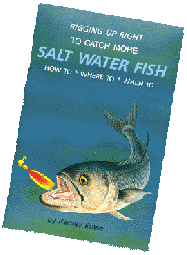
- Knots
- Terminal Tackle
- Fishing
- 8 Tips for Catching More Fish
- Gear
- Catching Fish
Book Excerpt
Boat Fishing - Trolling
- Breaking Fish:
- Troll surface or shallow running lures along the down-wind edge of the school. Trolling
through the fish will result in scattering or sounding the school.
- If one lure doesn't work, try another
- Subsurface:
- Try several different depths. Start halfway down by putting a 4 oz. to 6 oz. weight on
your line. If there isn't any action there, use a planer or down rigger to get nearer the bottom.
- When a school of fish is located use that depth rig as long as it works.
- Fish often go deeper in the afternoon to escape light
- If a school is not moving, drop a marker (plastic bottle) with enough line to reach the bottom.
Use 8 oz. to 10 oz. lead. If the fish move, haul in your marker & go with them.
- Speeds and length of line will vary from fish to fish, and with wind and water conditions
- The most common trolling speed is 4-6 knots. If this speed is not productive, vary speed
slightly.
- Length of trolling line varies, too. Generally, your lure will be fromm 100 to 150 feet
behind your boat. On a calm day, I use the following lengths of trolling:
- Bluefish: 100-150 feet of line
- Stripers: 75-150 feet
- Marlin: 50 feet
- Tuna: 50 feet (Troll on the fast side)
Knots - Which to Use When
- Improved Clinch
- The most widely used knot because it is easy and fast; can be used anywhere. Use it
to attach hook or lures to a swivel, or to a leader or line. A good knot for large lures or large
rigs, as the entire (terminal) rig does not have to pass through loop.
- Palomar
- Use to attach lures, swivels/snaps. The strongest way to attach your lure or hook to
swivel, leader or line; the line goes through the eye of the lure or hook twice for ouble strength.
Because of its strength, it's a favorite. The only place it shouldn't be used is with large rigs;
for them I use the improved clinch knot.
- Snelling A Hook
- It's one of the easiest ways to attach a hook to a line or a leader.
- Surgeon's End Loop
- Use to tie leader to terminal rigs; particularly if you plan to change rigs. An easy to tie
knot that does not slip and can be easily removed.
- Surgeon's Knot
- A way to tie 2 lines (leader to line) together. Even works with two different sized lines.
For information on obtaining these books, select from the options below:
Information Request Form
Return to Tackle Shop Helper Home Page




